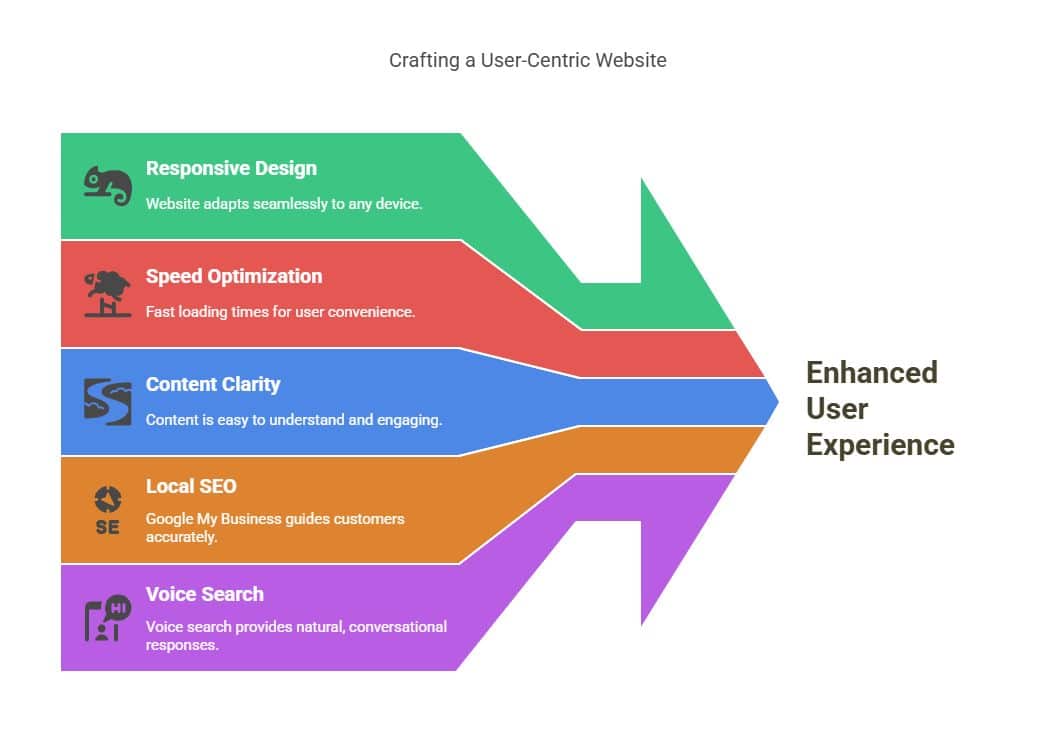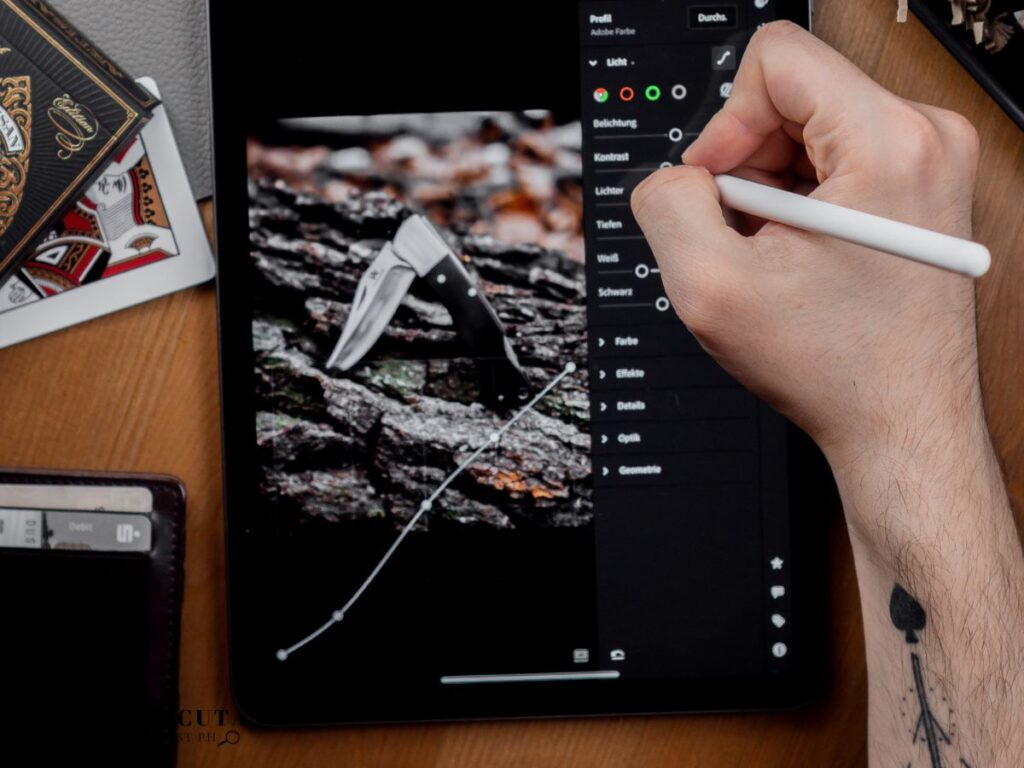
Mobile SEO Tips for Small Business Success
To help your small business thrive in the digital world, it’s essential to embrace mobile SEO strategies that put your customers first. Think of your website as your digital storefront – it needs to create an outstanding user experience that makes people want to stay and explore. Just like you’d ensure your physical store is welcoming and easy to navigate, your website should adapt smoothly to any device your customers use. Remember that today’s customers are always on the go. They’ll likely move on if your site takes too long to load, which is why optimizing page speed is crucial. Keep your content clear and easy to read on smaller screens – after all, nobody likes squinting at their phone to read tiny text. For local businesses like yours, local SEO is your secret weapon. Make sure your Google My Business listing is complete and up-to-date, just as you’d keep your physical business sign well-maintained. These mobile SEO tips for small businesses aren’t just technical requirements – they’re about creating a better online experience for your customers. By making your website more accessible and user-friendly, you’re not just improving your search rankings; you’re building a stronger connection with your community.
Key Takeaways
- Make your website feel like home on any device – whether your customers are browsing on their phone during lunch or relaxing with their tablet on the couch.
- Give your visitors the gift of time with a speedy website. After all, life’s too short for slow-loading pages!
- Keep things simple and sweet. Your content should be as easy to read as chatting with a friend over coffee.
- Think of Google My Business as your friendly neighborhood tour guide – let it show people right to your door with a warm, accurate welcome.
- When people talk to their phones looking for businesses like yours, be ready to answer in their language. It’s just like having a natural conversation with a curious customer.

Essential Mobile SEO Strategies

In today’s digital landscape, mastering essential mobile SEO strategies is crucial for small businesses aiming to enhance their online visibility and reach a broader audience.
As mobile device usage continues to surge, optimizing for mobile user experience is a key factor in achieving higher search engine rankings and ensuring customer satisfaction.
A fundamental aspect of mobile SEO is understanding the responsive design importance. Responsive design ensures that your website automatically adjusts to fit any screen size, thereby providing a seamless experience for users across all devices.
This adaptability not only enhances the mobile user experience but also signals to search engines that your site is optimized for modern browsing needs.
Another critical element is mobile page speed. Slow-loading websites can deter potential customers, as users typically abandon sites that take more than a few seconds to load.
Optimizing images, leveraging browser caching, and minimizing redirects are just a few strategies that can significantly improve mobile page speed, thereby reducing bounce rates and improving engagement.
Crafting mobile friendly content is equally important. Content should be concise, easily readable, and formatted to suit smaller screens.
Using bullet points, short paragraphs, and clear headings can enhance readability and keep users engaged.
Local SEO for Visibility
Frequently overlooked yet immensely valuable, local SEO serves as a powerful tool for small businesses seeking to enhance their visibility within specific geographic regions. By focusing on local SEO, businesses can effectively target potential customers in their immediate vicinity, leveraging the power of location-based searches.
A critical component of this strategy involves optimizing local citations, which are online mentions of a business’s name, address, and phone number. Consistent and accurate citations across various platforms help build credibility and improve a business’s ranking in local search results.
A cornerstone of local SEO is Google My Business (GMB). By claiming and optimizing their GMB listing, businesses can ensure that their information is prominently displayed when users conduct location-based searches. This includes updating business hours, adding high-quality images, and encouraging customer reviews.
Positive reviews not only enhance the business’s reputation but also significantly impact search rankings. Encouraging satisfied customers to share their experiences can lead to a more robust online presence and increased trust from potential clients.
Additionally, location targeting enhances a business’s ability to reach local audiences. Implementing location-specific keywords in website content, meta descriptions, and titles can further boost visibility in search results.
Complementing this with mobile friendly content ensures that users on smartphones and tablets have a seamless experience, crucial for capturing the growing number of mobile search users.
Optimizing for Mobile Devices

To stay ahead in the digital landscape, small businesses must adapt to the increasing prevalence of mobile device usage by optimizing their websites for mobile users. This entails enhancing the mobile user experience through several strategic approaches. Implementing responsive design techniques is vital, ensuring that web pages adjust seamlessly across various screen sizes and resolutions. This adaptability is crucial for engaging users who access websites via smartphones or tablets.
A key component of optimizing for mobile devices is improving mobile page speed. Faster loading times not only enhance user satisfaction but also positively impact search engine rankings. Techniques such as compressing images, minimizing code, and leveraging browser caching can significantly boost page speed, ultimately benefiting both users and business visibility.
Creating mobile-friendly content is another essential aspect. This involves structuring content that is easy to read and navigate on smaller screens, using concise paragraphs and bullet points. Furthermore, touch-friendly interfaces enhance the mobile user experience by ensuring buttons and links are easily clickable without requiring excessive zooming or scrolling.
To illustrate these concepts, consider the following table:
| Optimization Aspect | Key Focus |
| Responsive Design | Adaptability to screen sizes |
| Mobile Page Speed | Faster loading times |
| Mobile-Friendly Content | Easy readability |
| Touch-Friendly Interfaces | Usability of buttons |
Utilize Local SEO

Local search optimization is a crucial strategy for small businesses aiming to enhance their online visibility and attract nearby customers. By focusing on local SEO, businesses can ensure they appear prominently in search results when users are looking for services or products within their area.
One essential component is managing your Google My Business profile effectively. This free tool allows you to control how your business appears on Google Search and Maps, providing potential customers with vital information such as operating hours, contact details, and directions.
Incorporating local citations is another pivotal aspect. These are online mentions of your business, including its name, address, and phone number (NAP), across various websites and directories. Consistent local citations help search engines verify the legitimacy and location of your business, enhancing your local search rankings.
Furthermore, encouraging customer reviews can significantly impact your local SEO efforts. Positive reviews not only improve your business’s reputation but also influence search engine algorithms, making your business more likely to appear in local search results.
Developing location pages on your website is also beneficial, especially if your business operates in multiple areas. Each page should include specific local content, such as address details, customer testimonials, and localized keywords, to attract and engage a local audience effectively.
Lastly, building local backlinks, which are links from other local businesses and organizations to your site, can boost your website’s authority and relevance in local search results. By implementing these strategies, small businesses can significantly improve their local search presence and connect with their community more effectively.
Focus on Voice Search
As small businesses harness the power of local SEO to connect with nearby customers, embracing voice search optimization becomes increasingly important. The rise of voice search trends has reshaped the way consumers interact with technology, with a growing reliance on smart speaker usage and voice-activated assistants like Siri, Alexa, and Google Assistant. Understanding this shift is crucial for small businesses aiming to stay competitive in the digital landscape.
Voice search optimization requires a nuanced approach that differs from traditional text-based searches. Unlike typed queries, which are often concise, voice searches tend to be longer and more conversational. This is where conversational queries come into play. Users are more likely to ask complete questions, such as “Where is the nearest coffee shop?” rather than typing “coffee shop near me.” Consequently, businesses must adapt their SEO strategies to cater to these natural language patterns.
To effectively optimize for voice search, small businesses should focus on understanding user intent. This involves anticipating the questions potential customers might ask and providing clear, direct answers within their content.
Incorporating FAQs, using natural language, and ensuring mobile-friendly website design are key strategies. Moreover, leveraging local SEO can enhance visibility for location-based queries, crucial for attracting foot traffic.
Prioritize Mobile Keywords

Understanding the dynamics of mobile keyword optimization is essential for small businesses seeking to enhance their digital presence. In today’s fast-paced digital world, consumers increasingly rely on mobile devices for information, making it crucial for businesses to tailor their SEO strategies accordingly. Mobile keyword research forms the backbone of any successful mobile content strategy, enabling businesses to identify the specific terms and phrases potential customers use when searching on their smartphones.
One effective approach is to conduct competitor analysis to gain insights into what keywords similar businesses are targeting. This analysis helps in understanding which terms are driving traffic and which long tail keywords might be untapped opportunities. Long tail keywords, in particular, are invaluable for small businesses because they tend to be less competitive and more targeted, often leading to higher conversion rates.
Strategic keyword placement is another critical component of mobile SEO. Ensuring that chosen keywords are naturally integrated into key areas such as headings, subheadings, and throughout the content itself will improve visibility in search engine results pages. However, it’s vital to avoid keyword stuffing, as this can lead to penalties from search engines and disrupt the readability of the content.
A well-crafted mobile content strategy not only incorporates effective keyword usage but also considers the user experience. Content should be concise and engaging, providing value to the reader, while simultaneously being optimized for mobile view.
Improve Navigation

Effective navigation is pivotal for enhancing the mobile user experience and improving SEO performance for small businesses. A well-designed navigation system ensures that users can effortlessly locate information, leading to increased engagement and improved conversion rates.
In the realm of mobile design, where screen space is limited, achieving optimal navigation requires a strategic approach to user interface design.
Prioritizing simplicity is key. Overly complex menus and excessive links can overwhelm users, detracting from the overall user experience. Implementing a streamlined menu that highlights essential categories and subcategories can assist users in finding their desired content quickly and efficiently.
This simplicity not only makes navigation more intuitive but also contributes to faster site speed, which is a critical factor for both user satisfaction and SEO ranking.
Moreover, the use of clear and concise labeling in navigation elements is essential. Users should be able to predict the content they will find upon selecting a menu item. This predictability enhances user confidence, encouraging them to explore further and increasing the likelihood of conversion.
Additionally, integrating search functionality into the mobile design can provide an added layer of convenience, allowing users to directly locate specific information without navigating through multiple pages.
Optimize Images

Navigating mobile design extends beyond streamlined menus, touching upon the importance of optimizing images for enhanced user experience and SEO performance. In today’s mobile-centric world, images play a crucial role in the appeal and functionality of a website. For small businesses aiming to compete effectively, understanding how to optimize images can significantly impact site speed, user engagement, and search engine rankings.
Image compression is a fundamental practice that reduces file size without compromising quality, ensuring faster loading times on mobile devices. Tools such as TinyPNG or JPEGmini can help achieve this, making your site more accessible to users with varying internet speeds.
Alongside compression, selecting the appropriate file formats, such as WebP or optimized JPEGs, can further enhance performance by balancing quality and size.
Adding alt text to images is another critical aspect. Alt text serves as a descriptive tag for search engines and provides context for visually impaired users, thereby improving accessibility and SEO. Crafting concise, relevant descriptions helps search engines understand your content, potentially boosting visibility.
Responsive design is essential, ensuring images adapt seamlessly to different screen sizes and orientations. This adaptability enhances user experience, allowing visitors to engage with content effortlessly, regardless of their device.
Finally, lazy loading is a technique that defers the loading of images until they are needed, minimizing initial load times and saving bandwidth. By implementing lazy loading, you can maintain a fluid browsing experience, encouraging users to explore more pages.
Incorporating these strategies can position your small business for success in the increasingly competitive mobile landscape.
Final Thoughts
In today’s mobile-first world, small businesses must recognize that mobile SEO isn’t just about technical optimization—it’s about creating meaningful connections with customers through seamless digital experiences. By implementing responsive design, optimizing for local searches, embracing voice search capabilities, and maintaining a user-friendly mobile interface, businesses can build a strong digital presence that resonates with their local community.
Looking to elevate your small business’s mobile SEO strategy and boost your online visibility? Connect with Syville Gacutan, an experienced SEO Specialist in the Philippines. With proven expertise in mobile optimization, local SEO, and user experience enhancement, Syville can help your business thrive in the digital world. Contact Syville today and start transforming your website’s mobile performance.